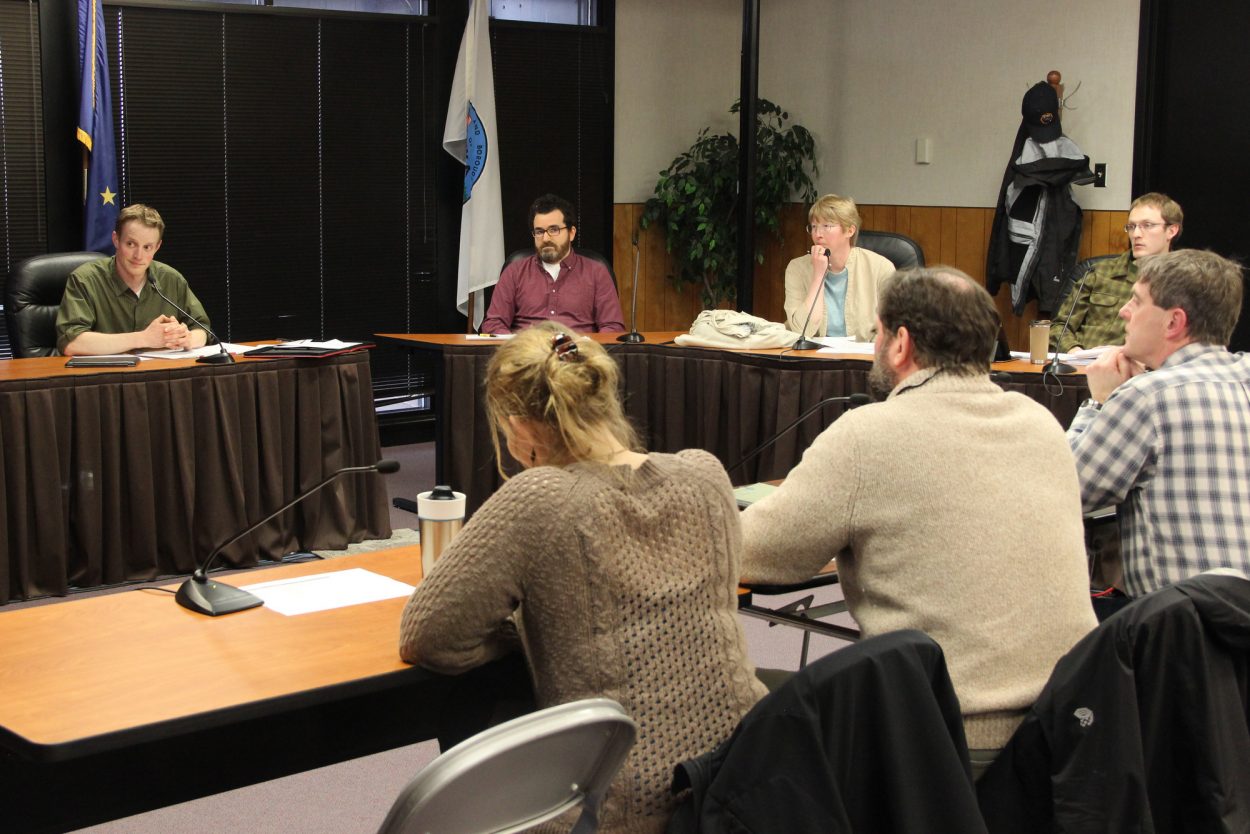
The Sitka School Board and Assembly met for a budget work session on April 9, 2015. (Rachel Waldholz/KCAW)
This week (Tuesday, 4-7-15), the Sitka School Board passed a budget on first reading that includes an additional $1-million in funding from the city. But the Sitka Assembly hasn’t yet voted on whether to give the district that money. And if they do, it’s not clear where the funding will come from.
Options range from eliminating sales tax exemptions to cutting library hours to selling the Senior Center — or putting a tax increase on the October ballot.
The School Board and Assembly opened that discussion at a work session on Thursday (4-9-15).
School Board President Lon Garrison set the tone for the meeting by reminding the Assembly that the situation is dire.
“Can the school district pull the rabbit out of the hat one more time? No, it can’t,” Garrison said. “There’s no more rabbits in the hat. And the hat is almost gone.”
The Sitka School District is facing a deficit of up to $3.3-million, out of a $20-million budget. That’s a shortfall of about 17%.
The deficit comes in part because of state budget cuts. The Alaska House and Senate combined have proposed about $80-million in education cuts statewide. That translates into more than $900,000 in cuts for Sitka. (The budget is now in conference committee between the House and Senate, so those numbers are not yet final.)
Meanwhile, federal Secure Rural Schools funding is also up in the air. That’s another $662,000.
The remaining deficit comes from increases in the cost of benefits, and pay raises negotiated with employee unions — plus the fact that the city has funded the district at essentially the same level for at least five years.
The budget passed by the School Board cuts three teacher positions, though the district hopes to achieve those cuts through attrition and retirements, rather than layoffs. It also cuts half a position in the district office. A divided School Board voted to spare the Blatchley Pool and Community Schools programs by taking the district’s reserves down to its absolute minimum level.
But all that assumes the city comes through with the additional $1-million.
On Thursday, City Administrator Mark Gorman emailed Assembly members a list of options for how the city might come up with that funding. The list includes eliminating sales tax exemptions or lifting the sales tax cap; doubling the tobacco tax; imposing a vehicle registration fee; and service cuts, like reducing the library to five days a week, or selling the senior center.
Assembly member Tristan Guevin said it’s also time to consider raising property taxes.
“We’ve talked about the increase in the millage rate. I think another idea worth exploring is an increase in millage rate for nonresidents,” Guevin said. “I think if you can own a second home in our community, you can help pay for schools, you can help pay for roads. Other communities have municipal income taxes. Can we institute a municipal income tax on top income earners?”
Most tax increases would have to be put up for a vote, in October’s municipal election.
Meanwhile, School Board members pointed out that they are currently shouldering the burden for resources used by the whole community.
School Board member Tim Fulton said he’s not sure how the schools came to be responsible for funding the Performing Arts Center, Blatchley Pool and the Community Schools program. He voted to keep the pool and Community Schools on Tuesday. But, he said, it may be time for the community to chip in more.
“These are all stuff that’s hitting our budget and taking money away from educating our students,” Fulton said. “I mean, it’s good stuff for our students, but it’s good stuff for the community as well.”
Last year, the city gave the School District about $300,000 for Community Schools and the pool. Another $79,000 has come in through user fees. That leave s the district responsible for about $375,000, largely in utility and insurance costs.
Assembly Member Michelle Putz suggested that perhaps it’s time to charge users more.
“It seems like it’s something that you could, this year, add into your budget, that you’re gonna increase the prices,” Putz said. “And that you’re going to expect the users that are so adamantly wanting it, to help pay for it, to at least help your budget.”
Finally, toward the end of the meeting, School Board member Cass Pook addressed the elephant in the room.
“And if I say anything to offend anybody, that’s not my intention,” Pook said. “But I’m gonna kick myself on the way out for not being honest with you guys. So this comes from me, and not the rest of the board. But I’ve been frustrated that we have not been funded to the cap.”
That’s the state cap, which limits how much a municipality can spend on its schools. Last year, city funding was about $1.9-million below the cap. (Though that figure doesn’t include the $430,000 the city kicks in for Community Schools, the pool, and student travel.)
And that means, even if the Assembly approves the additional $1-million in funding this year, the city will still be below the amount it could legally contribute.
Meanwhile, Garrison told the Assembly that as tough as this year is, next year will likely be worse. “The state is in such dire financial straits, and it’s not going to pull out of that for a decade,” he said. “We’re going to be dealing with this for a while.”
The Sitka Assembly will discuss its contribution to the School District budget at its next meeting, on Tuesday, April 14, at 6 PM in Harrigan Centennial Hall.
The School Board will then meet on Wednesday, April 15, in the Keet Gooshi Heen multipurpose room, to take a second vote on the budget.































